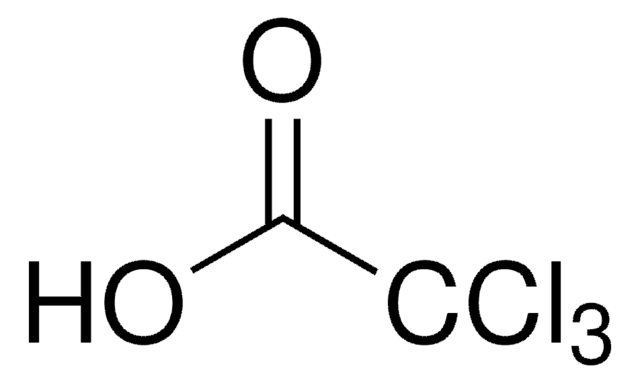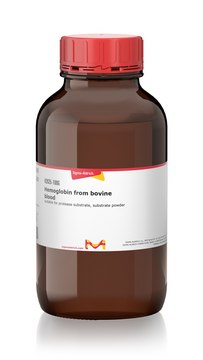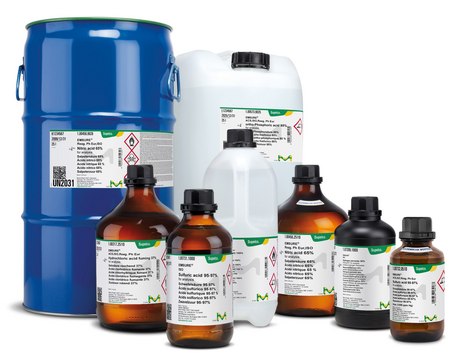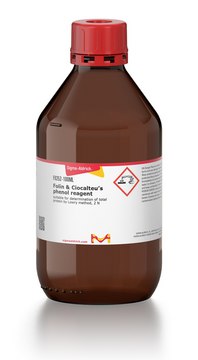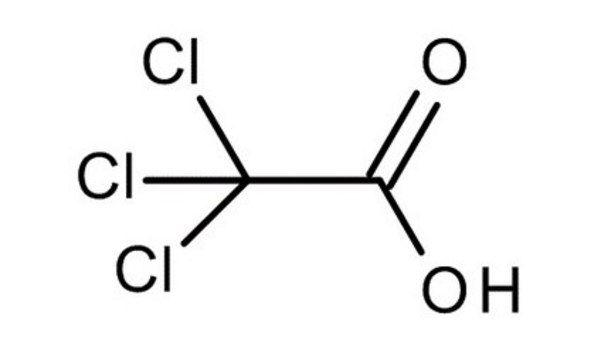49010
Trichloroacetic acid solution
6.1 N (approx. 100% w/v)
Synonym(s):
TCA
Sign Into View Organizational & Contract Pricing
Select a Size
All Photos(1)
Select a Size
Change View
About This Item
Linear Formula:
Cl3CCOOH
CAS Number:
Molecular Weight:
163.39
Beilstein:
970119
MDL number:
UNSPSC Code:
12352201
PubChem Substance ID:
Recommended Products
form
liquid
Quality Level
concentration
6.1 N (approx. 100% w/v)
SMILES string
OC(=O)C(Cl)(Cl)Cl
InChI
1S/C2HCl3O2/c3-2(4,5)1(6)7/h(H,6,7)
InChI key
YNJBWRMUSHSURL-UHFFFAOYSA-N
Looking for similar products? Visit Product Comparison Guide
Biochem/physiol Actions
Trichloroacetic acid solution is traditionally used to precipitate protein. It can be used to determine protein concentration by quantitative precipitation. Trichloroacetic acid can also be used as a decalcifier and fixative in microscopy.
replaced by
Product No.
Description
Pricing
Regulatory Information
新产品
Choose from one of the most recent versions:
Certificates of Analysis (COA)
Lot/Batch Number
It looks like we've run into a problem, but you can still download Certificates of Analysis from our Documents section.
If you need assistance, please contact Customer Support.
Already Own This Product?
Find documentation for the products that you have recently purchased in the Document Library.
Caio A C G Brunharo et al.
Journal of agricultural and food chemistry, 67(31), 8431-8440 (2019-05-09)
Glufosinate-resistant Lolium perenne L. spp. multiflorum biotypes from Oregon exhibited resistance levels up to 2.8-fold the field rate. One resistant biotype (MG) had an amino acid substitution in glutamine synthetase 2 (GS2), whereas the other (OR) exhibited the wild-type genotype.
Hikmat Al-Ahmadie et al.
Cancer discovery, 4(9), 1014-1021 (2014-06-18)
Metastatic solid tumors are almost invariably fatal. Patients with disseminated small-cell cancers have a particularly unfavorable prognosis, with most succumbing to their disease within two years. Here, we report on the genetic and functional analysis of an outlier curative response
Inga Müller et al.
PloS one, 9(5), e97285-e97285 (2014-05-27)
Members of the MYC family are the most frequently deregulated oncogenes in human cancer and are often correlated with aggressive disease and/or poorly differentiated tumors. Since patients with MYCN-amplified neuroblastoma have a poor prognosis, targeting MYCN using small molecule inhibitors
Valentina Folgiero et al.
Oncotarget, 5(8), 2052-2064 (2014-06-07)
Microenvironmental factors contribute to the immune dysfunction characterizing acute myeloid leukemia (AML). Indoleamine 2,3-dioxygenase 1 (IDO1) is an interferon (IFN)-γ-inducible enzyme that degrades tryptophan into kynurenine, which, in turn, inhibits effector T cells and promotes regulatory T-cell (Treg) differentiation. It
Makoto Yamagishi et al.
Scientific reports, 5, 17868-17868 (2015-12-08)
Biological robustness is exposed to stochastic perturbations, which should be controlled by intrinsic mechanisms; the promiscuous signaling network without appropriate alleviation is the true nature of cancer cells. B cell receptor (BCR) signaling is a major source of gene expression
Our team of scientists has experience in all areas of research including Life Science, Material Science, Chemical Synthesis, Chromatography, Analytical and many others.
Contact Technical Service